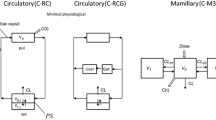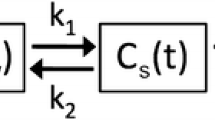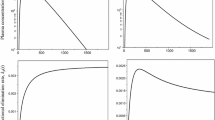Abstract
The gamma and Erlang density functions describe a large class of lagged, right-skewed distributions. The Erlang distribution has been shown to be the analytic solution for a chain of compartments with identical rate constants. This relationship makes it useful for the analysis of first-pass pulmonary drug uptake data following intravenous bolus administration and the incorporation of this analysis into an overall systemic drug disposition model. However, others have shown that one Erlang density function characterizes the residence time distribution of solutes in single tissues with significant systematic error. We propose a model of two Erlang density functions in parallel that does characterize well the arterial appearance of indocyanine green, antipyrine, and alfentanil administered simultaneously by right atrial bolus injection. We derive the equations that permit calculation of the higher order moments of a system consisting of two parallel Erlang density functions and use the results of these calculations from the data for all three indicators to estimate pulmonary capillary blood volume and mean transit time in the dog.
Similar content being viewed by others
References
C. Post. Studies on the pharmacokinetic function of the lung with special reference to lidocaine.Acta Pharmacol. Toxicol. (Copenh) 1:1–53 (1979).
D. L. Roerig, K. J. Kotrly, C. A. Dawson, S. B. Ahlf, J. F. Gualtieri, and J. P. Kampine. First-pass uptake of verapamil, diazepam, and thiopental in the human lung.Anesth. Anal. 69:461–466 (1989).
J. A. Jacquez,Compartmental Analysis in Biology and Medicine, Second Ed., The University of Michigan Press, Ann Arbor, 1985.
S. H. Audi, G. S. Krenz, J. H. Linehan, D. A. Rickaby, and C. A. Dawson, Pulmonary capillary transport function from flow-limited indicators.J. Appl. Physiol. 77:332–351 (1994).
S. H. Audi, J. H. Linehan, G. S. Krenz, C. A. Dawson, S. B. Ahlf, and D. L. Roerig. Estimation of the pulmonary capillary transport function in isolated rabbit lungs.J. Appl. Physiol. 78:1004–1014 (1995).
T. K. Henthorn, M. J. Avram, T. C. Krejcie, C. A. Shanks, and D. A. Kaczynski. Minimal compartmental model of circulatory mixing of indocyanine green.Am. J. Physiol. 262:H903-H910 (1992).
T. C. Krejcie, T. K. Henthorn, C. A. Shanks, and M. J. Avram. A recirculatory model describing the circulatory mixing, tissue distribution and elimination of antipyrine in dogs.J. Pharmacol. Exp. Ther. 269:609–619 (1994).
Y. F. Huang, R. N. Upton, L. E. Mather, and W. B. Runciman. An assessment of methods for sampling blood to characterize rapidly changing blood drug concentrations.J. Pharm. Sci. 80:847–851 (1991).
D. M. Grasela, M. L. Rocci, and P. H. Vlasses. Experimental impact of assay-dependent differences in plasma indocyanine green concentration determinations.J. Pharmacokin. Biopharm. 15:601–613 (1987).
M. J. Avram and T. C. Krejcie. Determination of sodium pentobarbital and either sodium methohexital or sodium thiopental in plasma by high performance liquid chromatography with ultraviolet detection.J. Chromatogr. 414:484–491 (1987).
S. Björkman and D. R. Stanski. Simultaneous determination of fentanyl and alfentanil in rat tissue by capillary gas chromatography.J. Chromatogr. 433:95–104 (1988).
K. L. Zierler. Circulation times and the theory of indicator-dilution methods for determining blood flow and volume. In W. F. Hamilton (ed.),Handbook of Physiology, Circulation, Vol. 1, Section 2, American Physiological Society, Washington, D.C., pp. 585–615, 1962.
W. O. Cua, G. Basset, F. Bouchonnet, R. A. Garrick, G. Saumon, and F. P. Chinard. Endothelial and epithelial permeabilities to antipyrine in rat and dog lungs.Am. J. Physiol. 258:H1321-H1333 (1990).
E. M. Renkin. Effects of blood flow on diffusion kinetics in isolated perfused hind legs of cats: A double circulation hypothesis.Am. J. Physiol. 183:125–136 (1955).
T. K. Henthorn, T. C. Krejcie, and M. J. Avram. The relationship between alfentanil distribution kinetics and cardiac output.Clin. Pharmacol. Ther. 52:190–196 (1992).
S. Björkman, D. R. Wada, D. R. Stanski, and W. F. Ebling. Comparative physiological pharmacokinetics of fentanyl and alfentanil in rats and humans based on parametric singletissue models.J. Pharmacokin. Biopharm. 22:381–409 (1994).
M. S. Roberts, J. D. Donaldson, and M. Rowland. Models of hepatic elimination: Comparisons of stochastic models to describe residence time distributions and to predict the influence of drug distribution, enzyme heterogeneity, and systemic recycling on hepatic elimination.J. Pharmacokin. Biopharm. 16:41–83 (1988).
R. L. Capen, L. P. Latham, and W. W. Wagner. Comparison of direct and indirect measurements of pulmonary capillary transit times.J. Appl. Physiol. 62:1150–1154 (1987).
J. C. Hogg, B. A. Martin, S. Lee, and T. McLean. Regional differences in erythrocyte transit times in normal lungs.J. Appl. Physiol. 59:1266–1271 (1985).
W. W. Wagner, Jr., L. P. Latham, W. L. Hanson, S. E. Hoffmeister, and R. L. Capen. Vertical gradient of pulmonary capillary transit times.J. Appl. Physiol. 61:1270–1274 (1986).
J. C. Hogg, T. McLean, B. A. Martin, and B. Wiggs. Erythrocyte transit and neutrophil concentration in the dog lung.J. Appl. Physiol. 65:1217–1225 (1988).
R. W. Glenny and H. T. Robertson. Fractal properties of pulmonary blood flow: characterization of spatial heterogeneity.J. Appl. Physiol. 69:532–545 (1990).
G. S. Krenz, L. Jianming, C. A. Dawson, and J. H. Linehan. Impact of parallel heterogeneity on a continuum model of the pulmonary arterial tree.J. Appl. Physiol. 77:660–670 (1994).
Y. W. Zhen, S. E. Cross, and M. S. Roberts. Influence of physicochemical parameters and perfusate flow rate on the distribution of solutes in the isolated perfused rat hindlimb determined by the impulse-response technique.J. Pharm. Sci. 84:1020–1027 (1995).
S. Björkman, D. R. Stanski, D. Verrotta, and H. Harashima. Comparative tissue concentration profiles of fentanyl and alfentanil in humans predicted from tissue/blood partition data obtained in rats.Anesthesiology 72:865–873 (1990).
G. Clausen, A. Hope, and K. Aukland. Partition of125I-iodoantipyrine among erythrocytes, plasma and renal cortex in the dog.Acta Physiol. Scand. 107:63–68 (1979).
Author information
Authors and Affiliations
Additional information
Supported in part by the National Institute of General Medical Sciences RO1-GM-43776, RO1-GM-47502, and PO1-GM-47819.
Rights and permissions
About this article
Cite this article
Krejcie, T.C., Jacquez, J.A., Avram, M.J. et al. Use of parallel erlang density functions to analyze first-pass pulmonary uptake of multiple indicators in dogs. Journal of Pharmacokinetics and Biopharmaceutics 24, 569–588 (1996). https://doi.org/10.1007/BF02353481
Received:
Accepted:
Published:
Issue Date:
DOI: https://doi.org/10.1007/BF02353481




